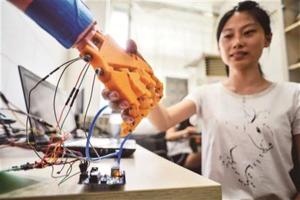Lu XiYi is a student of Computer and Control Engineering at Nankai University in China, where she and a team of fellow students developed this special 3D printed prosthetic. As they explained, they hope that this special hand will also help users to regain some of their consciousness and sensitivity in their arm and what they do with it. So how does it work? As the designer explains, this 3D printed ‘
These signals are sent to the micro control panel embedded in the prosthetic, and whenever a high temperature is recorded the mechanical grip immediately loosens its grip. Just like you and I would put something down that’s too hot, a disabled person’s prosthetic will automatically do the same. But perhaps more importantly, the micro control panel also sends an electric signal up to the end of the prosthetic, where it comes into contact with the wearer’s muscles. Through a sharp, but not painful, shock the wearer immediately knows it’s too hot, just like we would.

‘This way, people with disabilities will be able to feel the temperature of an object,’ Lu Siyi said. ‘The higher the grabbed object’s temperature is, the stronger the signal from Micro Control Board will be. This reflects the real physiological response when humans touch hot objects.’ Hopefully, this will enable disabled people who’ve lost limbs to regain some aspects of consciousness. ‘For persons with disabilities, their biggest wish is to live like normal people,’ the project’s supervisor Duan Feng said, who is the Associate Professor of the engineering department of Nankai University. ‘This prosthetic will, to some extent, provide the disabled with better living facilities and help them avoid injury.’
It is understood that the basic functioning of this interesting prosthetic have now been completed and that the prototype has moved on towards debugging and testing. With a bit of luck, disabled people can start to benefit from this clever design in the near future. Now if only the same could be done for scratches and pressure.


